Introduction
The Ohio-class submarines are the largest submarines ever built in the United States. These formidable vessels are second in size only to the Soviet Typhoon-class (Project 941) SSBNs and Russian Borei-class (Project 955) SSBNs. The Typhoon class, in particular, has a displacement more than twice that of the Ohio-class.
The primary role of the Ohio-class submarines, equipped with Trident missiles, is to provide the principal strategic deterrent for the United States. In the 2000s, the first four ships from this class were removed from their strategic role and converted into cruise missile/transport submarines (SSGNs).
General specifications
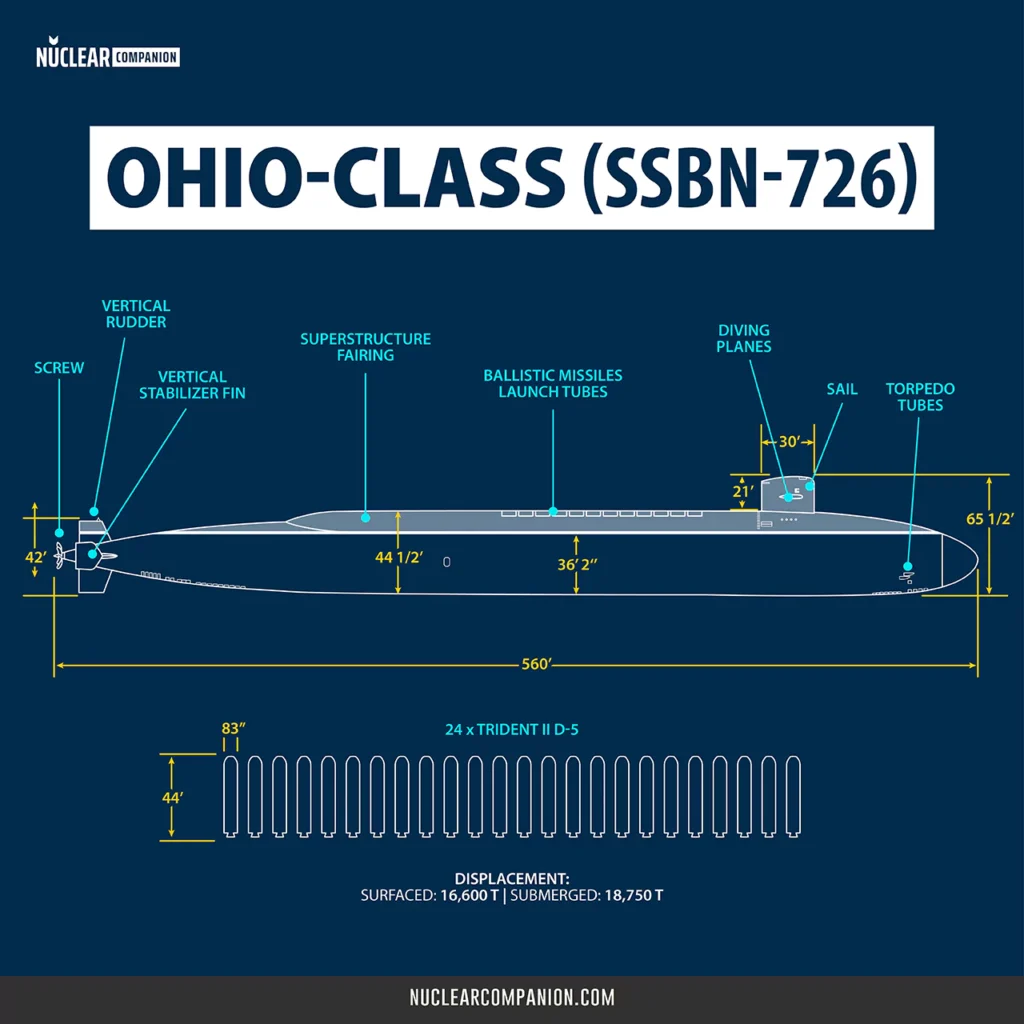
The Ohio-class submarines feature a traditional design, unlike the Soviet Typhoon. The Ohio’s missile tubes are located behind the sail area, and its diving planes are positioned traditionally on the sail rather than forward.
The external shape of the Ohio’s hull is symmetrical, except for the superstructure area covering the missile magazine, where the side-by-side nesting of twelve pairs of two tubes each necessitates some flattening.

The sail of the Ohio class bears the traditional two diving planes. These planes are inclined during dives or ascents to help direct the submarine down or up, in conjunction with the stern elevators. The degree of incidence of these controls can be varied independently or fully coordinated, depending on the maneuver.
Dimensions:
– Length: 170.7 m (560 ft)
– Beam: 12.8 m (42 ft)
– Draught: 11.1 m (36.4 ft)
Speed (submerged): 20+ kts
Diving depth: 300 m (984 ft)
Displacement:
– Surfaced: 16,600 t
– Submerged: 18,750 t
Complement: 155 (14 officers in first 6, 15 in remainder)
Compartments
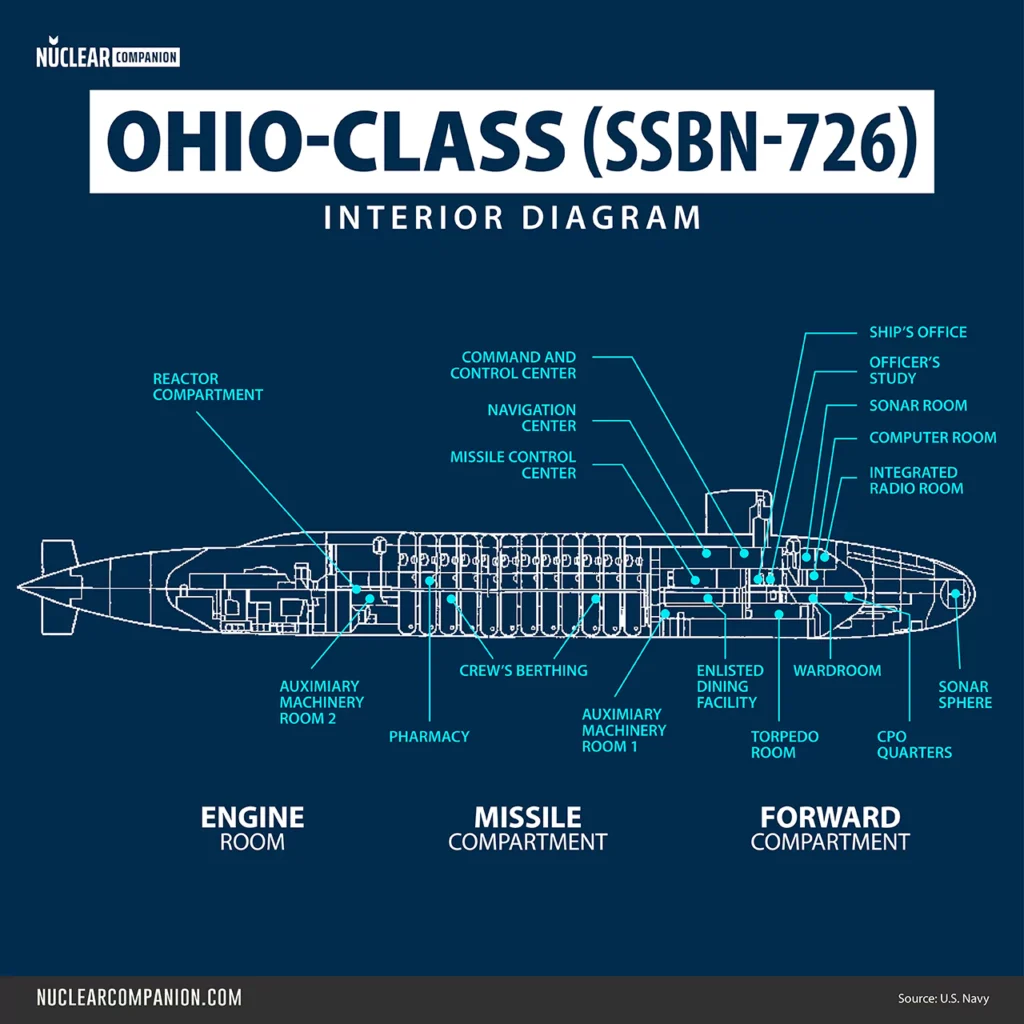
The ship’s structure, which houses and provides a controlled environment for the crew and equipment, is divided into four watertight compartments and a hydrodynamically shaped fairwater (sail) section.
Forward Compartment– This compartment includes the tactical support area (torpedo, sonar, and radio rooms; command and control center; navigation center; missile control center), ship and environmental support (air conditioning and data processing rooms, Auxiliary Machinery Room No. 1, battery compartment), and personnel support (senior officers’ staterooms, officers’ quarters, chief petty officers’ quarters, pantry, galley, and crew’s mess).
Missile Compartment– Divided into the missile section and Auxiliary Machinery Room No. 2 section, it houses 24 Trident missiles, missile launcher equipment, crew berthing and study areas, electrical power equipment, switchboards, oxygen generator, and trim pumps.
Reactor Compartment– The reactor compartment contains the S8G nuclear reactor and equipment required for reactor operation.
Engine Compartment– The engine compartment contains power-generating equipment, control panels, hydraulic equipment, and propulsion equipment.
Fairwater Section– The sail contains the housing for periscopes, radio antennas, sonar hydrophones, and hydraulic equipment for the diving planes.
Weapons Systems

The first eight Ohio-class submarines (SSBN 726-733) were initially equipped with Trident I missiles. Starting with USS Tennessee (SSBN 734), the submarines were outfitted with the larger and more advanced Trident II missiles.
In the 2000s, the first four boats (SSBN 726-729) were converted into cruise missile/transport submarines (SSGNs). Concurrently, SSBN 730-733 were upgraded to carry Trident II missiles.
24 x UGM-96 Trident I (C4) on SSBN 726-733
The Trident I (C4) missile, deployed on the first eight Ohio-class submarines (SSBN 726-733), was a Lockheed-manufactured strategic weapon system. Featuring stellar inertial guidance, it had an impressive range of up to 7,400 km (4,000 nautical miles).
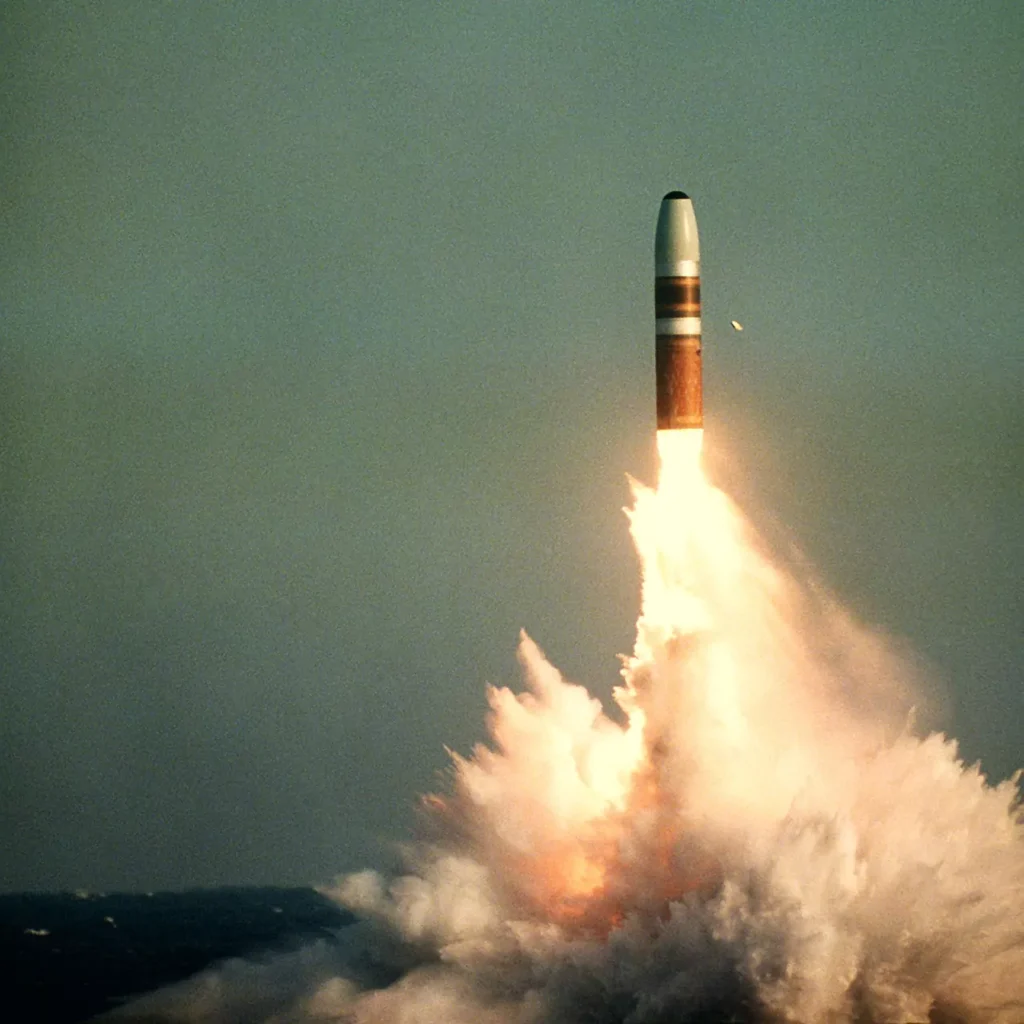
Each missile could carry up to eight Multiple Independently Targetable Reentry Vehicles (MIRVs), each with a thermonuclear warhead yielding 100 kilotons. The missile boasted a Circular Error Probable (CEP) of 450 meters.
These ships as part of the TRIDENT I Strategic Weapon System needed to carry the following Trident I support systems:
- Fire Control System: MK 98 Mod 0
- Launcher system: Mk 35 Mod 0
- Launcher Control Group: Mk 13 Mod 0
- Launcher Ejector Group: Mk 9 Mod 0
- Launch Tube Group: Mk 14 Mod 0
- MTRE: Mk 6 y Mk 7
- Missile Handling Group: Mk 6 Mod 0
24 x UGM-133 Trident II (D5) on SSBN 734 onwards
The Trident II missile, also known as the Trident D5, is a Lockheed-manufactured submarine-launched ballistic missile (SLBM) deployed on Ohio-class submarines. It features stellar inertial guidance and boasts an extended range of up to 12,000 km (6,500 nautical miles).
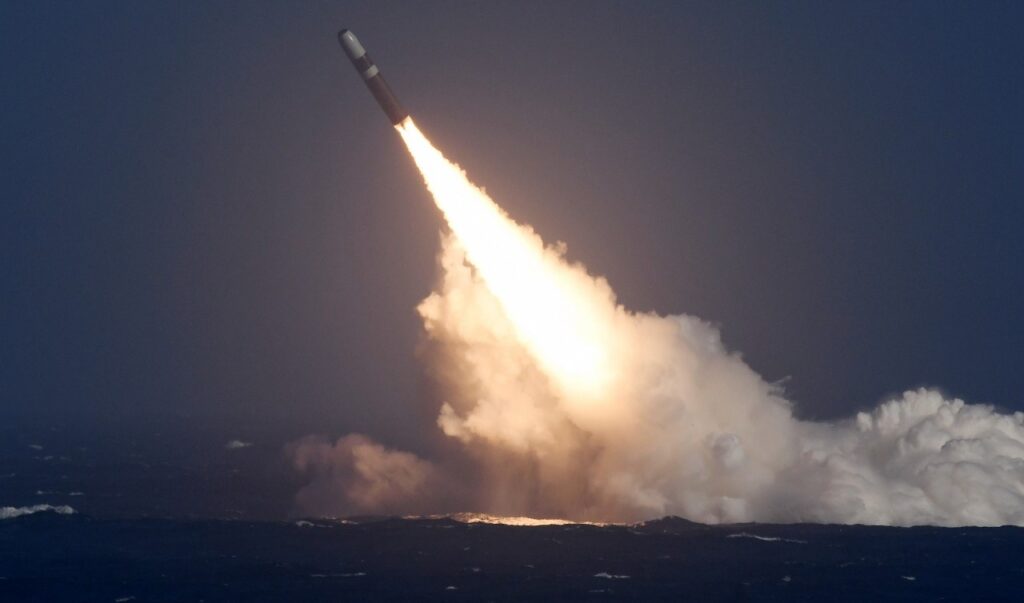
This missile can have up to 12 Multiple Independently Targetable Reentry Vehicles (MIRVs), each carrying thermonuclear warheads. The warheads can be either Mk 4 with W76 yielding 100 kilotons each or Mk 5 with W88 yielding 475 kilotons each. The Trident II’s accuracy is notable, with a Circular Error Probable (CEP) of just 90 meters.
The ships as part of the TRIDENT II Strategic Weapon System need to carry the following Trident II support systems:
- Fire Control System: MK 98 Mod 1
- Launcher system: Mk 46 Mod 0
- Launcher Control Group: Mk 157 Mod 0
- Launcher Ejector Group: MK 18 Mod 0
- MTRE: Mk 9 y Mk 10
Launch sequence
The launch sequence for Trident missiles on Ohio-class submarines follows a precise “ripple” fire format to maintain balance and ballast. Instead of firing sequentially, missile 1 is followed by missile 24, then missile 2, and so on, ensuring the submarine remains stable.
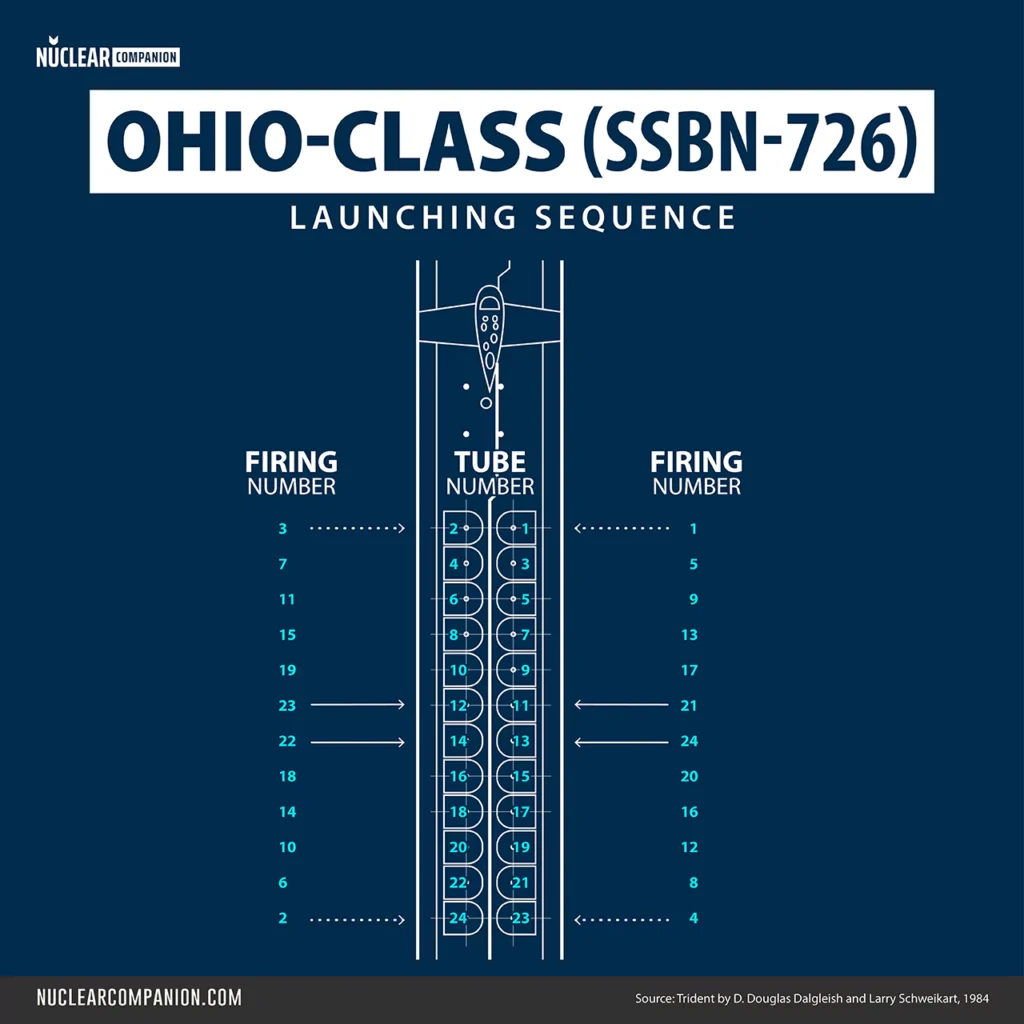
Historically, the SSBN 643 USS George Bancroft took approximately 56.6 seconds per missile, totaling less than fifteen minutes for its sixteen Poseidon missiles.
Applying this to the Ohio class, the estimated total firing time for twenty-four Trident I missiles would be slightly under twenty-three minutes. However, due to advanced fire-control systems, the actual sequence is believed to be much faster, potentially under six minutes for Trident I and slightly more for Trident II missiles.
Tubes
Trident SSBNs are equipped with four bow-mounted 21-inch (533-mm) Mk 68 torpedo tubes capable of launching torpedoes.
Torpedoes
A magazine of 12 Mk 48 Torpedoes ADCAP Mod 5/6/7 is carried on each ship. The Mk 48 torpedo is a high-speed, deep-running, long-range torpedo that is wire-guided and launched from submarines. It is designed to target both submarines and surface vessels.
Electronic Warfare Systems
Electronic Support Measures
AN/WLR-8(V)5
The AN/WLR-8(V) system is primarily designed as an Electronic Support Measures (ESM) system, with the (V)5 variant being specific to Trident-class submarines. This system detects, locates, analyzes, and records electronic emissions across the electromagnetic spectrum, covering frequencies from 0.5 to 18 GHz. In addition to its ESM role, the AN/WLR-8(V) provides critical threat warning capabilities.
AN/WLR-10
The AN/WLR-10 is a radar warning receiver with recording capability. This receiver is fitted to a retractable mast and is collocated with the AN/WLR-8 system.
ADC Mk 2 Mod 1
The Ohio-class submarines have eight launchers for the ADC (Acoustic Device Countermeasure) Mk 2 Mod 1. This expendable, submarine-launched decoy is designed to counter acoustic torpedoes. Measuring 8 cm (3 inches) in diameter, the ADC Mk 2 Mod 1 hovers vertically at a preselected depth, emitting an acoustic signal to divert incoming torpedoes.
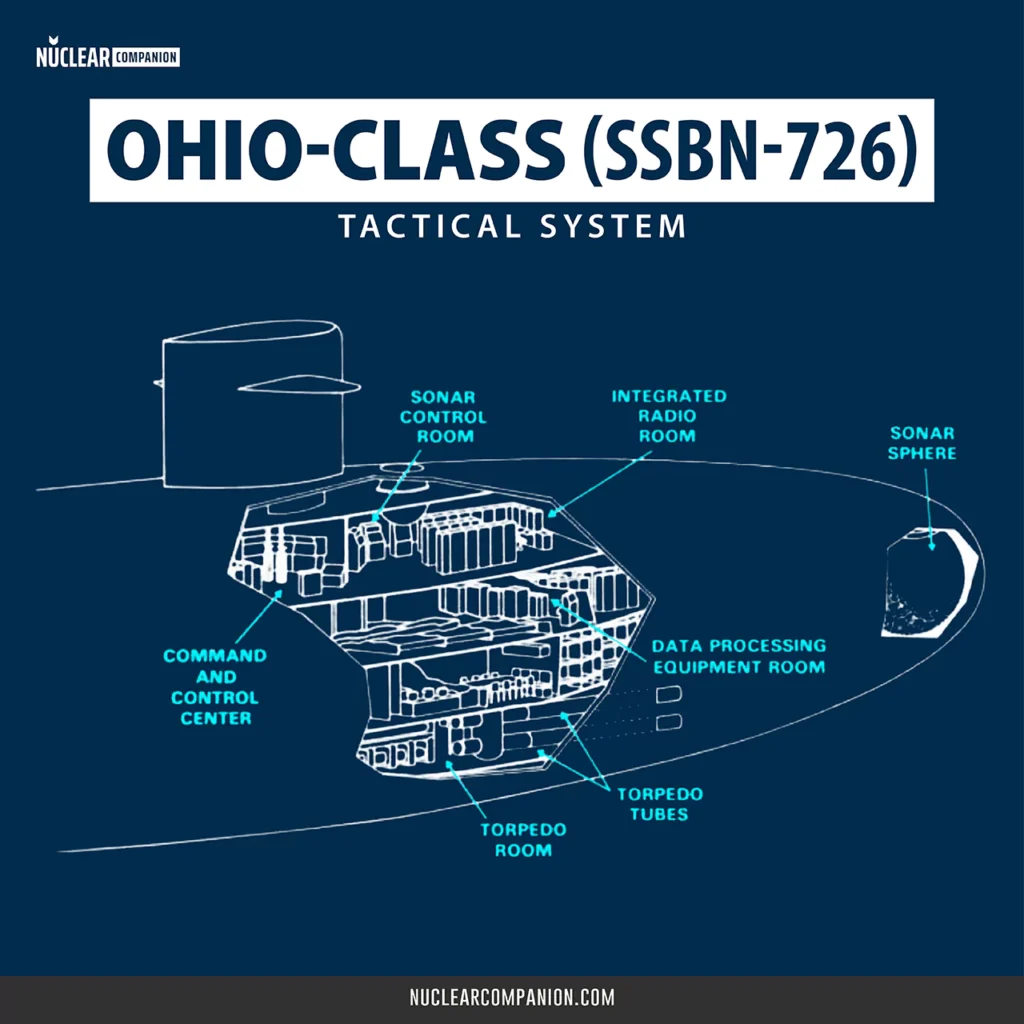
Command and Control Systems
Combat Data Systems
Command and Control System Mk 3 (CCS Mk 2)
The CCS MK 2 command and control system is integrated into the Ohio-class submarines. This system provides comprehensive command and control, weapons control, target motion analysis (TMA), and over-the-horizon (OTH) targeting capabilities.
The core of the system is the Paramax AN/UYK-43 computer, supported by a UYK-44 for processing OTH targeting software. Additionally, a CP-2037/UYK parallel processor enhances the speed of target track correlation.
The primary sensor integrated into the CCS MK 2 is the IBM AN/BQQ-6 sonar suite, which is similar to the AN/BQQ-5 but lacks an active element.
Weapons Control
MK 98 fire-control system
Although all specific details remain classified, the Mk 98 fire-control system manages the selection, targeting, and launching of the Trident II (D5) SLBMs.
MK 118 Torpedo Fire Control System
The Mk 118 fire-control system is used for torpedo operations, which is an all-digital system developed specifically for the Trident SSBNs. This system is similar to the Mk 117 installed in the US Navy’s SSNs. The Mk 118 controls torpedo launches, the release of 3-inch and 6-inch torpedo countermeasures, and the deployment of Mark 70 MOSS target simulators.
Navigation
Periscopes
For periscopes, Ohio-class ballistic-missile submarines use two types: the Type 8L, mounted to starboard, and the Type 15L, mounted to port. Both periscopes support antennas, with the Type 8L featuring an ST range-only periscope radar and the Type 15L designed for tactical Electronic Support Measures (ESM).
These periscopes serve as general-purpose search periscopes, making the Ohio class unique in its lack of a specialized attack periscope.
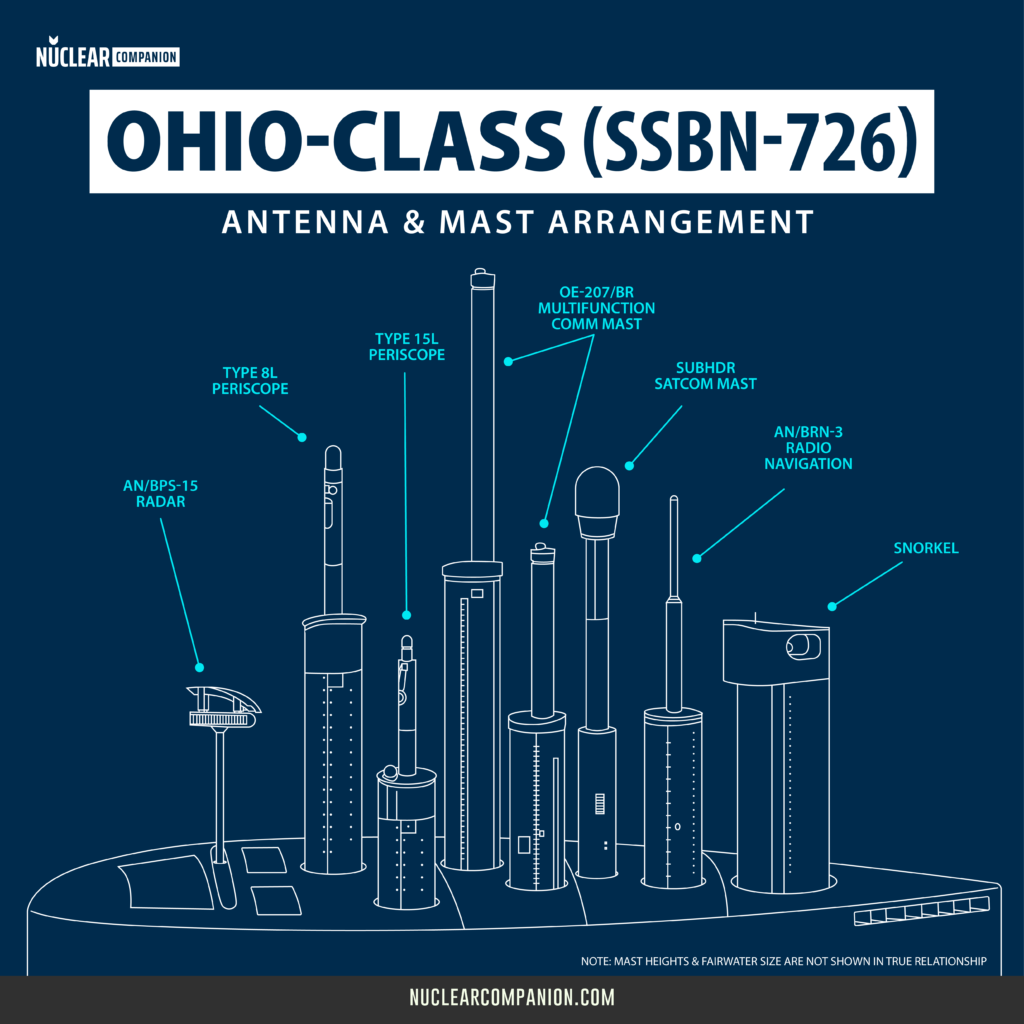
Navigation System
Each Ohio-class submarine utilizes two Mk 2 Mod 7 Ship’s Inertial Navigation Systems (SINS) supported by an Electro-statically Supported Gyro (ESG) Monitor to ensure accuracy.
These systems, initialized with the ship’s latitude, longitude, heading, and orientation, continuously calculate the ship’s current latitude and longitude by detecting acceleration.
Radar
For surface search and navigation, the AN/BPS-15 Radar is installed on SSBN 726-740 submarines, while the AN/BPS-16 Radar is installed on SSBN 741-743 submarines.
Sonar
Initially, Ohio-class submarines were equipped with the IBM AN/BQQ-6 sonar suite. This system is a passive-only version of the AN/BQQ-5 used in Los Angeles-class submarines but includes significant enhancements.
Key components of the suite are the Raytheon AN/BQS-13 bow-mounted spherical hydrophone array and the Western Electric AN/BQR-15 passive towed array. Additionally, the suite features the Ametek AN/BQS-15 for close contact detection and the Raytheon AN/BQR-19 mast-mounted high-frequency active sonar for surfacing.
These submarines have since been refitted with the AN/BQQ-10 ARCI sonar update, replacing the original BQQ-6. The first SSBN to receive the ARCI update was USS Alaska (SSBN 732) in the fall of 2000.
Note: ARCI = Acoustic Rapid COTS [Commercial-Off=The-Shelf] Insertion.
Propulsion
The class is powered by an S8G nuclear reactor designed to produce 60,000 shaft horsepower (shp). This makes it one of the most powerful U.S. naval reactors, surpassed only by the A4W reactors on Nimitz-class aircraft carriers and the A1B reactors on Gerald R. Ford-class carriers.
The Ohio-class design requires a mid-life nuclear refueling typically around 20 years into the submarine’s operational life.
System: Nuclear
Reactor: One General Electric S8G, natural circulation, pressurized water reactor (PWR)
Steam turbines: 2 geared General Electric turbines
Power output: 44.8 MW (60,000 hp)
Shafts: 1
—-
Auxiliary propulsion: 1 Magnetek electric auxiliary prop motor
Power output: 242 kW (325 hp)
—-
Auxiliary propulsion: 1 Fairbanks-Morse 38 8-1/8 two-stroke opposed-piston diesel engine
Power output: 1600 Hp
Further reading
- United States Submarine-Launched Ballistic Missiles (SLBM)
- Ohio-Class (SSBN-726) Ballistic Missile Submarines
Bibliography
- Dalgleish, D. D., Schweikart, L. (1984). Trident. United States: Southern Illinois University Press.
- Jane’s Major Warships. (1997). United Kingdom: Jane’s Information Group.
- Polmar, N. (2013). The Naval Institute Guide to the Ships and Aircraft of the U.S. Fleet. United Kingdom: Naval Institute.
- Saunders, S., Philpott, T. (2015). Jane’s Fighting Ships 2015-2016. United Kingdom: Jane’s Information Group.